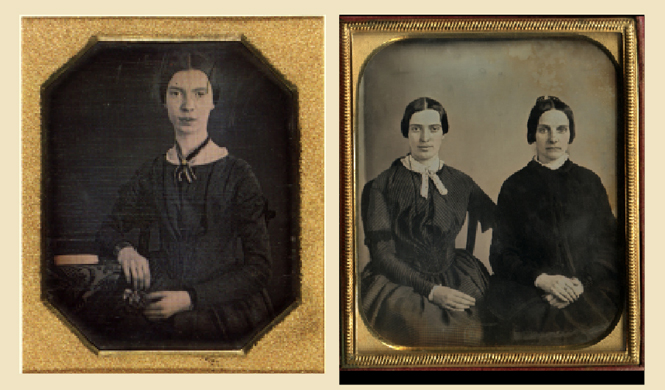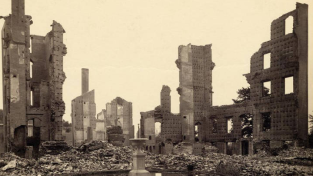Is That You, Emily Dickinson?
Newly Discovered Daguerreotype Could be Only Second Known Photo of the Poet

Scholars and scientists compare the only authenticated image of Dickinson (left) to the newly surfaced daguerreotype (right).
Images courtesy of the Emily Dickinson Museum and the Amherst College Archives and Special Collections
While the one authenticated image of Emily Dickinson has become an iconic portrait, for the past 125 years scholars and enthusiasts have only been able to peer into the eyes of the inscrutable poet as a sixteen-year-old, nearly twenty years before she produced some of the most celebrated poetry in American history. Recently, though, a private collector acquired what may be a second daguerreotype of Dickinson, taken c. 1859–1860. Believed to be near the age of thirty, Emily Dickinson (class of 1849) would have sat for the picture roughly ten years after she left Mount Holyoke. The image shows two women seated side by side. The woman on the right is confirmed to be Kate Scott Turner, a widow and close friend of the Dickinson family. Seated on the left is our mystery woman, purported to be Emily.
While it remains unverified that the image is in fact of Dickinson, at least one expert has weighed in and claims that this is no phony. Susan Pepin, director of neuro-opthalmology at Dartmouth Medical School, conducted a careful comparison of the early, confirmed daguerreotype with the newly discovered one. Dickinson had astigmatism in one of her eyes, making her pupils asymmetrical, a trait that is apparent in both images. Other physical similarities exist, such as the shape of the right earlobe and the alignment of the area between the nose and upper lip. Clothing may be an additional indicator of identity, as the dress worn by the woman on the left is about a decade out of style (in line with what we know of the reclusive poet), and the fabric in the photo closely matches a swatch owned by the Emily Dickinson Museum.
All of this adds up to the promising prospect that the woman on the left is the one of the most enigmatic personas of the literary world. Amherst College and the Emily Dickinson Museum are continuing their investigation with further clothing and image analysis.
View video of Dickinson scholar Chris Benfey discussing the portraits.
This article appeared in the winter 2013 issue of the Alumnae Quarterly.
December 18, 2012










I can see why people are excited about this photograph! The women do strongly resemble each other. But I have doubts that this really is Emily and Kate. I found this person’s facial analysis to be very persuasive:
http://i581.photobucket.com/albums/ss259/bmarlowe1/Dickinsoncompariso.jpg
http://i581.photobucket.com/albums/ss259/bmarlowe1/turnercomparison.jpg
Also, watch last few seconds of this 28-second video. The ears on the mystery woman are much, much higher than on Emily. A woman’s ears would not relocate so much over the span of a few years. http://www.youtube.com/watch?v=oYfdk4bi5GY
I’d love this to really be Emily. But I have my doubts.
This is amazing news! She looks….like a woman in the 2nd daguerreotype. I experience an odd sense of loss for the young E.D., which I wasn’t expecting. The “new” E.D. looks more serious, stately, with a whiff of pain around the eyes but also a determined confidence, as Mr Benfy identifiies. He asks a good question, what do we want E.D. to look like? I join her conversation. Rather, our conversation.
As I am in the midst of reading “Lives Like Loaded Guns, Emily Dickinson and Her Family’s Feuds” (Lyndall Gordon) the timing couldn’t be better. Ms Gordon writes well. Her belief that E.D. had epilepsy seems accurate (I am not an E.D. scholar so this may be old news). This story makes her more alive to me.